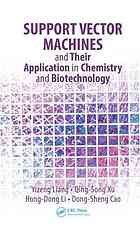Support Vector Machines and Their Application in Chemistry and Biotechnology 2011
دانلود کتاب پزشکی پشتیبانی از ماشین های بردار و کاربردهای آنها در شیمی و بیوتکنولوژی
| نویسنده |
Dong-Sheng Cao, Hong-Dong Li, Qing-Song Xu, Yizeng Liang |
|---|
| تعداد صفحهها |
211 |
|---|---|
| نوع فایل |
|
| حجم |
3 Mb |
| سال انتشار |
2011 |
89,000 تومان
دستگاههای بردار پشتیبانی (SVM) در طیف وسیعی از کاربردها، از جمله طراحی دارو، کنترل کیفیت غذا، تجزیه و تحلیل اثر انگشت متابولیک و طبقهبندی سرطان مبتنی بر دادههای ریزآرایه استفاده میشوند. در حالی که بیشتر ریاضیدانان به خوبی از ویژگیهای متمایز و عملکرد آزمایشی SVM آگاه هستند، بسیاری از شیمیدانان و زیستشناسان از چیستی و نحوه عملکرد آنها آگاه نیستند. ماشینهای بردار پشتیبان و کاربردهای آنها در شیمی و بیوتکنولوژی با ارائه پل روشنی بین تئوری و عمل، توصیف جامعی از مکانیسم SVM از دیدگاه شیمیدانان و زیستشناسان ارائه میدهد و آنها را قادر میسازد تا با کمک این ابزار قدرتمند، مسائل دشوار را حل کنند. .
موضوعات مورد بحث عبارتند از:
- زمینه و عناصر کلیدی برای پشتیبانی از ماشین های برداری و برنامه های کاربردی در شیمی و تکنولوژی Vitality
- عناصر و الگوریتمهای طبقهبندی بردار پشتیبان (SVC) و ماشینهای رگرسیون بردار پشتیبان (SVR)، به همراه بحث در مورد مجموعه دادههای شبیهسازی شده
- عملکرد هسته برای حل مسائل غیرخطی با استفاده از یک روش تبدیل خطی ساده
- آموزش ماشین بردار پشتیبانی از اسمبلی
- برنامه های ماشین بردار پشتیبانی برای داده های مادون قرمز نزدیک
- ماشین های بردار پشتیبانی و ساختار کوانتومی – فعالیت/ارتباط خصوصی ( QSAR/QSPR)
- کنترل کیفیت Q طب سنتی چینی با کروماتوگرافی
- استفاده از ماشین های بردار پشتیبان در کاوش داده های بیولوژیکی تولید شده در مطالعه OMICS
برای تجزیه و تحلیل دادههای شیمیایی و مدلسازی سیستمهای پیچیده فیزیکی، شیمیایی و بیولوژیکی مفید است، ماشینهای بردار پشتیبان در زمینههای بیشماری امیدوارکننده هستند. این کتاب غیرریاضیدانان را قادر می سازد تا پتانسیل SVM ها را در طیف وسیعی از کاربردها درک کرده و از آن استفاده کنند.
Support vector machines (SVMs) are used in a range of applications, including drug design, food quality control, metabolic fingerprint analysis, and microarray data-based cancer classification. While most mathematicians are well-versed in the distinctive features and empirical performance of SVMs, many chemists and biologists are not as familiar with what they are and how they work. Presenting a clear bridge between theory and application, Support Vector Machines and Their Application in Chemistry and Biotechnology provides a thorough description of the mechanism of SVMs from the point of view of chemists and biologists, enabling them to solve difficult problems with the help of these powerful tools.
Topics discussed include:
- Background and key elements of support vector machines and applications in chemistry and biotechnology
- Elements and algorithms of support vector classification (SVC) and support vector regression (SVR) machines, along with discussion of simulated datasets
- The kernel function for solving nonlinear problems by using a simple linear transformation method
- Ensemble learning of support vector machines
- Applications of support vector machines to near-infrared data
- Support vector machines and quantitative structure-activity/property relationship (QSAR/QSPR)
- Quality control of traditional Chinese medicine by means of the chromatography fingerprint technique
- The use of support vector machines in exploring the biological data produced in OMICS study
Beneficial for chemical data analysis and the modeling of complex physic-chemical and biological systems, support vector machines show promise in a myriad of areas. This book enables non-mathematicians to understand the potential of SVMs and utilize them in a host of applications.




